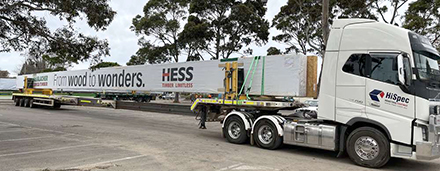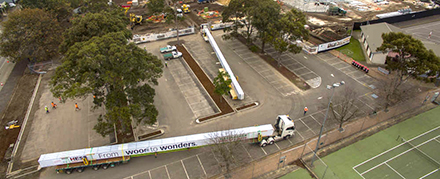The longest single glulam timber beams ever shipped to Australia – spanning up to 42 metres – have been delivered to Mount Gambier in South Australia. The timber rafters were crafted at Hess Timber’s production facility in Kleinheubach, Germany. Source: Timberbiz
The beams departed from Zeebrugee Terminal in Belgium at the end of April and travelled approximately 25,000 kilometres via ocean to Australia as break-bulk-cargo, arriving at the wharf in Port Melbourne in early July.
They were loaded on to two trucks to make the two-day journey from a wharf in Port Melbourne to the Wulanda Recreation and Convention Centre construction site on Margaret Street in Mount Gambier.
The beams and two segmented beams were produced by German timber engineering project specialist Hess Timber for the swimming pool hall within the $57.3 million Wulanda development.
“Timber was chosen as a feature following a feasibility assessment and extensive architectural research,” City of Mount Gambier Wulanda Recreation and Convention Centre Project Sponsor Barbara Cernovskis said.
“Timber is resistant to corrosion in an aquatic environment, has whole of life benefits for health, maintenance and operational costs and aligns closely with the original architectural intent.”
The single large timber spans required for the roof meant the European Spruce product was sourced from overseas as the length was unable to be manufactured in Australia.
“Understanding the nature of the use of the facility, and what it means to the community over a number of generations, our priority was ensuring longevity of the build that would ultimately reduce long-term maintenance costs,” BADGE Senior Construction Manager Mark Wyatt said.
“This particular product was selected as it will not require joins, given its length will span the roof. Those joins are where moisture and chemicals from an aquatic environment can begin to damage structure over years of use, as would any plain timber product,” he said.
“There is a real opportunity for this project to be a catalyst to further expand the knowledge and technology of timber construction within Australia, showcase the benefits of timber construction and promote the timber industry.”







